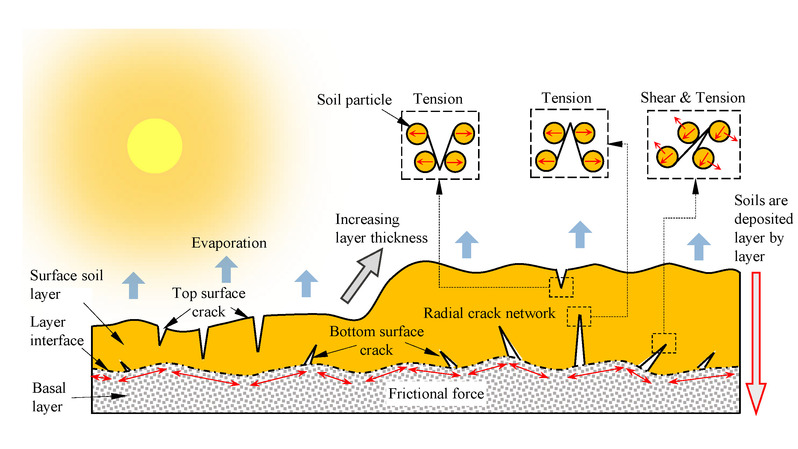Responding to drought, soil desiccation cracking as a natural phenomenon is projected to be intensified especially in arid and semi-arid regions and may cause a series of environmental problems. For instance, desiccation cracks enlarge soil macro pore size and evaporation surface, accelerate the evaporation rate of pore water, lower water retention capacity of soil and degrade its physical and mechanical properties. This drives the desertification process and brings severe damage to the local ecological environment. Cracks also aggravate the weathering of soil bodies and the subsequent soil erosion from slopes, inducing potential geological disasters like landslides and debris flow due to weak hydro-mechanical behaviors of crack soil. Similar problems subjected to drought climate have happened in many other countries like China and Australia, which severely impacts local economy and environment. Therefore, it is of great importance to understand the soil cracking behavior, so as to improve human capacity to react to problems with climate loading.
Soils in nature distribute layer by layer along the vertical direction, due to the effect of natural sedimentation process. This results in the horizontally layered soils (fine-textured or coarse-textured) with various physical/mechanical properties.For each soil layer, physical properties such as mineral composition, compaction state, grain size and particle shape are different. The frictional force generated on the base between soil interlayers applies a significant constraint to the upper soil shrinkage and causes the soil desiccation cracking. Furthermore, soil layer thickness is associated with the weight of the overlying soil and further affects the normal stress acting on the base. Moreover, soil layer thickness impacts internal stress evolution and soil volume change as the evaporation rate profile and suction profile in the soil matrix are also influenced by soil layer thickness. Prof. Chao-sheng Tang’ research group, in School of Earth Sciences and Engineering, Nanjing University, performs a series of tests to investigate the effects of basal friction and layer thickness on soil desiccation cracking behavior. Experimental results validate that the coupled effects of basal conditions and soil layer thickness play a key role in governing the soil cracking behavior. The presence of rough bottom surface induces the onset and propagation of desiccation cracks at both top and bottom surfaces. Some of the cracks initiated at the bottom do not propagate through the soil profile. Increasing layer thickness weakens the effect of basal friction on the soil top surface shrinkage, but increases the frictional force acting on the base and results in more crack initiations at the bottom. By the non-contact optical technique-Digital Image Correlation (DIC), it is further revealed that cracks initiated on the bottom surface and propagated upward vertically are dominated by tensile stresses, while those propagated upward obliquely are dominated by the joint action of shear and tensile stresses.
This study reveals that crack initiation depends on both basal boundary conditions and soil layer thickness. Desiccation cracks that form within the interior of the soil layers and do not propagate through the soil layer are not visible from the top surface. Therefore, the conventional evaluation method of using only surface cracks for soil assessment may underestimate the negative impacts of climate and environmental changes on the soil mass (Fig. 1). This study helps guide the design of clay materials for environmental engineering and earth structure applications in arid or semi-arid regions and provides new insights into the desiccation cracking of clayey soils under the impact of local environment and global climate changes.

Fig. 1. Graphical representation of the effect of basal boundary condition and layer thickness on soil desiccating cracking behavior.
This work was published in Water Resources Research entitled as “Drought-Induced Soil Desiccation Cracking Behavior with Consideration of Basal Friction and Layer Thickness”. It can be accessed via this link: http://dx.doi.org/10.1029/2019WR026948. The authors would like to thank the founding for this work from the National Natural Science Foundation of China (Grant No. 41925012, 41902271, 41572246, 41772280), Natural Science Foundation of Jiangsu Province (Grant No. BK20171228, BK20170394), National Science Foundation of China for Excellent Young Scholars (Grant No. 41322019) and the Fundamental Research Funds for the Central Universities.

